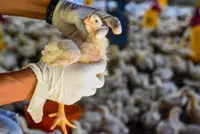The hoopoe has become increasingly rare in Germany, compared to the 19th century when they could be found nationwide. Photos: dpa
Residents in Europe can count themselves very lucky indeed if they spot a Eurasian hoopoe as the birds migrate north from Africa.
The cinnamon-coloured birds have an eye-catching crest, black and white wings and a curving beak – and give a soft “oop-oop-oop” call.
Already a subscriber? Log in
Save 30% OFF The Star Digital Access
Cancel anytime. Ad-free. Unlimited access with perks.





